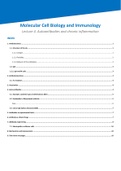Class notes
Lecture 4. Autoantibodies and chronic inflammation (AM_470656)
- Course
- Institution
- Book
Information on the basis of antibodies, function, role in vaccination and development of auto-antibodies. Antibodies as experimental tools, clinical drugs and engineering.
[Show more]




